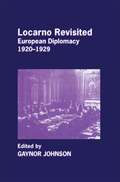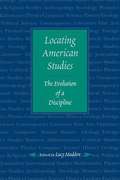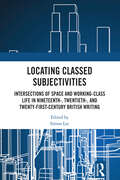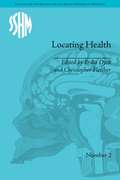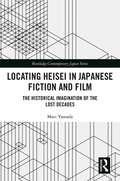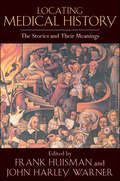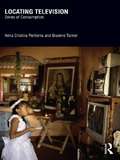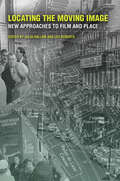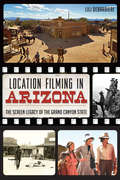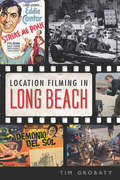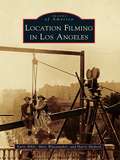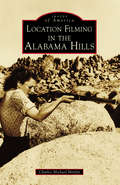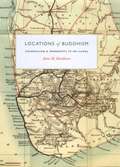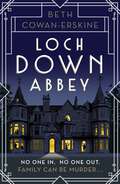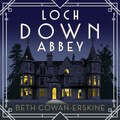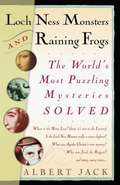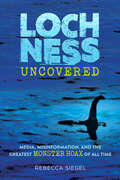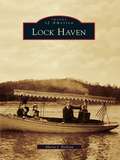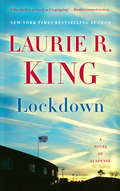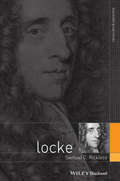- Table View
- List View
Locarno Revisited: European Diplomacy 1920-1929
by Gaynor JohnsonThis collection of essays examines European politics and diplomacy in the 1920s, with special emphasis on the Treaty of Locarno of 1925, often seen as the 'real' peace treaty at the end of the First World War.Contributors discuss the diplomacy of the principle countries that signed the Treaty of Locarno in 1925 and consider the issues of greatest importance to the study of European history in the 1920s. They also assess whether the treaty could be seen as the 'real' peace treaty with Germany at the end of the First World War. Key chapters include: Locarno, Britain and the Security of Europe; Locarno: Early Test of Fascist Intentions; Locarno and the Irrelevance of Disarmament.'Locarno diplomacy' meant different things to each of the countries involved. The inability of contemporaries to arrive at a working consensus about what the treaty was intended to achieve weakened it and paved the way for its destruction. Unlike the Paris Peace Conference, however, the Treaty of Locarno and the era of diplomacy to which it gave its name, were not always seen as flawed. Until 1945, they were held up as one of the high points of European diplomacy in the 1920s. This book asks whether it is still appropriate to under-rate the importance of the Treaty of Locarno
Locating American Studies: The Evolution of a Discipline
by Lucy MaddoxLocating American Studies is a collection of seventeen essays first printed in American Quarterly, the journal of the American Studies Association. To mark the Association's celebration of its 50th anniversary in 1998, Lucy Maddox has brought together works by a distinguished group of scholars which "provide a useful window into the history and the evolution of the practice of American studies from its early, formational days to the present." Each essay, originally published between 1950 and 1996, is accompanied by a commentary in which a scholar from a related field provides useful critical information for understanding the continuing importance of the work to the American Studies field. Contributors include Gene Wise, Henry Nash Smith, Bruce Kuklick, R. Gordon Kelly, Robert Berkhofer Jr., Barbara Welter, Linda Kerber, Nina Baym, Janice Radway, Alexander Saxton, Houston Baker, Jr., George Lipsitz, Ramon Gutierrez, Kevin Mumford, and K. Scott Wong. "If the frequency with which an essay is cited in subsequent scholarship and assigned as required reading in academic courses may be taken as an indication of the respect it has achieved and the importance it has been granted, then many of the essays in this volume have come to be considered milestones, even classics, in the scholarly literature of American studies." -- from the Introduction by Lucy Maddox
Locating August Strindberg's Prose
by Anna Westerstahl StenportThe setting of a novel is more than just an anonymous, interchangeable backdrop. In Locating August Strindberg's Prose, Anna Westerståhl Stenport argues that spatial setting is a key - though often neglected - tool for exploring the fundamentals of European literary modernism.Stenport examines the importance of location by exploring the prose of Swedish exile August Strindberg (1849-1912), challenging previous studies of the author that have focused on identity and subject formation. Strindberg wrote in both Swedish and French, situating his stories in various places across Europe - from Berlin to the French countryside, the Austrian Alps, and Stockholm - to purposely destabilize concepts of national belonging, language, and literary history. Close readings of Strindberg's prose find that his boundary-challenging narratives redefine and rewrite the meaning of a marginal literary identity. By contextualizing Strindberg against other early modernists, including Kafka, Conrad, Rilke, and Breton, Stenport emphasizes the burgeoning transnationality of literature at the turn of the last century.
Locating Classed Subjectivities: Intersections of Space and Working-Class Life in Nineteenth-, Twentieth-, and Twenty-First-Century British Writing
by Simon LeeLocating Classed Subjectivities explores representations of social class in British fiction through the lens of spatial theory and analysis. By analyzing a range of class-conscious texts from the nineteenth-, twentieth-, and twenty-first centuries, the collection provides an overview of the way British writers mobilized spatial aesthetics as a means to comment on the intricacies of social class. In doing so, the collection delineates aesthetic strategies of representation in British writing, tracing the development of literary forms while considering how authors mobilized innovative spatial metaphors to better express contingent social and economic realities. Ranging in coverage from early-nineteenth-century narratives of disease to contemporary writing on the working-class millennial, Locating Classed Subjectivities offers new perspectives on literary techniques and political intentions, exploring the way class is parsed and critiqued through British writing across three centuries. As such, the project responds to Nigel Thrift and Peter Williams’s claim that literary and cultural production serves as a particularly rich yet unexamined access point by which to comprehend the way space and social class intersect.
Locating Health: Historical and Anthropological Investigations of Place and Health (Studies for the Society for the Social History of Medicine #2)
by Erika Dyck Christopher FletcherThe essays in this collection focus on the dynamic relationship between health and place. Historical and anthropological perspectives are presented – each discipline having a long tradition of engaging with these concepts. The resulting dialogue should produce a new layer of methodology, enhancing both fields.
Locating Heisei in Japanese Fiction and Film: The Historical Imagination of the Lost Decades (Routledge Contemporary Japan Series)
by Marc YamadaThis book provides the first interdisciplinary examination of the popular fiction and film of the “lost decades” of Japan’s Heisei period (1989–2019). Presenting original analysis of major Heisei writers, filmmakers, and manga artists, the chapters examine the work of Urasawa Naoki, Kurosawa Kiyoshi, Murakami Haruki, and Shinkai Makoto, among others. Through the work of these cultural figures, the book also explores the struggle to define the history of Heisei—three decades of economic stagnation, social malaise, and natural disaster. In particular, it explores the dissonance between the dominant history of Japan’s recent past and the representation of this past in the popular imagination of the period. In so doing, this book argues that traumatic events from the years leading up to Heisei complicate the narration of a cohesive sense of history for the period, requiring works of fiction and film to explore new connections to the past. Incorporating literary and film theory to assess the works of culture, Locating Heisei in Japanese Fiction and Film will be useful to students and scholars of Japanese culture, society, and history.
Locating Medical History: The Stories and Their Meanings
by Frank Huisman and John Harley WarnerThe issues constituting the history of medicine are consequential: how societies organize health care, how individuals or states relate to sickness, how we understand our own identity and agency as sufferers or healers. In Locating Medical History: The Stories and Their Meanings, Frank Huisman, John Harley Warner, and other eminent historians explore and reflect on a field that accommodates a remarkable diversity of practitioners and approaches.At a time when medical history is facing profound choices about its future, these scholars explore the discipline in the distant and recent past in order to rethink its missions and methods today. They discuss such issues as the periodic estrangement of medical history from medicine, the influence of Foucault on the writing of medical history, and the shifts from social to cultural history and back again. Chapters explore the early history of the field, its transformations since the 1970s, and its prospects for the future.With diverse constituencies, a multiplicity of approaches, styles, and aims is both expected and desired. This volume locates medical history within itself and within larger historiographic trends, to provide a springboard for discussions about what the history of medicine should be, and what aims it should serve.Contributors: Olga Amsterdamska, University of Amsterdam; Warwick Anderson, University of Wisconsin, Madison; Allan M. Brandt, Harvard Medical School; Theodore M. Brown, University of Rochester; Roger Cooter, University College London; Martin Dinges, Institut für Geschichte der Medizin der Robert Bosch Stiftung; Alice Domurat Dreger, Michigan State University; Jacalyn Duffin, Queen's University; Elizabeth Fee, National Library of Medicine; Mary E. Fissell, The Johns Hopkins University; Danielle Gourevitch, École Pratique des Hautes Études; Anja Hiddinga, University of Amsterdam; Ludmilla Jordanova, University of East Anglia; Alfons Labisch, Heinrich-Heine-University; Hans-Uwe Lammel, University of Rostock; Sherwin B. Nuland, Yale University; Vivian Nutton, University College London; Roy Porter, formerly University College London; Susan M. Reverby. Wellesley College; David Rosner, Columbia University; Thomas Rütten, University of Newcastle upon Tyne; Heinz-Peter Schmiedebach, University of Greifswald; Christiane Sinding, Institut National de la Santé et de la Recherche Médicale
Locating Television: Zones of Consumption
by Graeme Turner Anna Cristina PertierraLocating Television: Zones of Consumption takes an important next step for television studies: it acknowledges the growing diversity of the international experience of television today in order to address the question of ‘what is television now?’ The book addresses this question in two interrelated ways: by situating the consumption of television within the full range of structures, patterns and practices of everyday life; and by retrieving the importance of location as fundamental to these structures, patterns and practices – and, consequently, to the experience of television. This approach, involving collaboration between authors from cultural studies and cultural anthropology, offers new ways of studying the consumption of television – in particular, the use of the notion of ‘zones of consumption’ as a new means of locating television within the full range of its spatial, temporal, cultural, political and industrial contexts. Although the study draws its examples from a wide range of locations (the US, the UK, Australia, Malaysia, Cuba, and the Chinese language markets in Asia - -Hong Kong, Singapore, China and Taiwan), its argument is strongly informed by the evidence and the insights which emerged from ethnographic research in Mexico. This research site serves a strategic purpose: by working on a location with a highly developed and commercially successful transnational television industry, but which is not among the locations usually considered by television studies written in English, the limitations to some of the assumptions underlying the orthodoxies in Anglo-American television studies are highlighted. Suitable for both upper level students and researchers, this book is a valuable and original contribution to television, media and cultural studies, and anthropology, presenting approaches and evidence that are new to the field.
Locating the Moving Image: New Approaches to Film and Place (The Spatial Humanities)
by Julia Hallam and Les RobertsEssays exploring the methodologies used by film scholars to develop a spatial history of the moving image.Leading scholars in the interdisciplinary field of geo-spatial visual studies examine the social experience of cinema and the different ways in which film production developed as a commercial enterprise, as a leisure activity, and as modes of expression and communication. Their research charts new pathways in mapping the relationship between film production and local film practices, theatrical exhibition circuits and cinema going, creating new forms of spatial anthropology. Topics include cinematic practices in rural and urban communities, development of cinema by amateur filmmakers, and use of GIS in mapping the spatial development of film production and cinema going as social practices.“Introduces some of the concrete ways practical mapping and GIS technologies help elaborate historical film projects. . . . The scope of many of these projects is breathtaking in scale. . . . Others embrace ethnographic methods that tell poignant individual stories. Still others deftly merge qualitative and quantitative approaches. . . . As a whole, the volume brings together disparate fields of study in interesting ways.” —James Craine, California State University, Northridge“This collection breaks new ground for cinema history. Hallam and Roberts have gathered some of the foremost scholars who are mapping spatial histories of the moving image and the geographies of film production, distribution and consumption. Introducing new interdisciplinary methods and asking new questions, Locating the Moving Image takes film studies into new territory, beyond the boundaries of the text and its interpretation, towards an understanding of the relationship between culture, spatiality and place.” —Richard Maltby, Matthew Flinders Distinguished Professor of Screen Studies, Flinders University
Location Filming in Arizona: The Screen Legacy of the Grand Canyon State
by Lili DebarbieriThe scenic natural vistas of Arizona's deserts and mountains have made it a favorite backdrop of movies and television shows. Westerns such as silent-era pictures derived from Zane Grey fiction through the John Ford-John Wayne classics "Stagecoach "and "The Searchers "benefited from the beautiful and rugged landscapes. TV classics such as "Gunsmoke" and "Little House on the Prairie" helped define Arizona's allure for Hollywood. Oscar winners "Jerry Maguire" and "Little Miss Sunshine "took advantage of the infrastructure that accumulated to lure filmmakers to Tucson, Yuma, Phoenix, Prescott, Sedona and all corners of the Grand Canyon State". Join author Lili DeBarbieri as she looks at the movies and shows shot in the state, as well as other aspects of Arizona film culture.
Location Filming in Long Beach
by Tim GrobatyLong Beach's proximity to Hollywood has made the waterfront city a picturesque and easily accessed locale for hundreds of films and television shows. Silent movies produced by Balboa Studios here starred Fatty Arbuckle and Buster Keaton, and the city's resume includes the Oscar-winning best pictures The Best Years of Our Lives (1946) and American Beauty (1999). Cameras continue to roll in the port metropolis, which has been host for such TV favorites as CHiPs and The Mod Squad and now twenty-first-century series such as NCIS, Dexter and CSI: Miami. Longtime newspaperman Tim Grobaty has been watching, in person and in his living room, and tracks the history of the city on celluloid in the comprehensive Location Filming in Long Beach.
Location Filming in Los Angeles
by Marc Wanamaker Karie Bible Harry MedvedLos Angeles has reigned for more than a century as the world capital of the film industry, a unique and ever-changing city that has been molded and recast thousands of times through the artistic visions and cinematic dreams of Hollywood's elite. As early as 1907, filmmakers migrated west to avoid lengthy eastern winters. In Los Angeles, they discovered an ideal world of abundant and diverse locales blessed with a mild and sunny climate ideal for filming. Location Filming in Los Angeles provides a historic view of the diversity of locations that provided the backdrop for Hollywood's greatest films, from the silent era to the modern age.
Location Filming in the Alabama Hills
by Charles Michael MorfinForged from glaciers and sacred to Native Americans, the mountains, boulders, and rocks of the Alabama Hills mirror landscapes found all over the world. A scenic three-hour drive from the Hollywood sign, this location would prove to serve as the place to make movies. Early Hollywood studios sent location scouts to the area after hearing stories shared by travelers, and the rest is movie history. Over 500 films have completed shooting here, including silents, A movies, B Westerns, serials, sci-fi, film noir, television shows, and commercials. Tom Mix, Errol Flynn, John Wayne, William Boyd, Clayton Moore, Lucille Ball, Roy Rogers, Natalie Wood, Humphrey Bogart, Steve McQueen, Russell Crowe, Jamie Foxx, and many more have all scrambled amongst the terrain in the Alabama Hills.
Locations of Buddhism: Colonialism and Modernity in Sri Lanka
by Anne M. BlackburnModernizing and colonizing forces brought nineteenth-century Sri Lankan Buddhists both challenges and opportunities. How did Buddhists deal with social and economic change; new forms of political, religious, and educational discourse; and Christianity? And how did Sri Lankan Buddhists, collaborating with other Asian Buddhists, respond to colonial rule? To answer these questions, Anne M. Blackburn focuses on the life of leading monk and educator Hikkaduve Sumangala (1827-1911) to examine more broadly Buddhist life under foreign rule. InLocations of Buddhism, Blackburn reveals that during Sri Lanka's crucial decades of deepening colonial control and modernization, there was a surprising stability in the central religious activities of Hikkaduve and the Buddhists among whom he worked. At the same time, they developed new institutions and forms of association, drawing on pre-colonial intellectual heritage as well as colonial-period technologies and discourse. Advocating a new way of studying the impact of colonialism on colonized societies, Blackburn is particularly attuned here to human experience, paying attention to the habits of thought and modes of affiliation that characterized individuals and smaller scale groups. Locations of Buddhismis a wholly original contribution to the study of Sri Lanka and the history of Buddhism more generally.
Locations of Buddhism: Colonialism and Modernity in Sri Lanka (Buddhism And Modernity Ser.)
by Anne M. BlackburnModernizing and colonizing forces brought nineteenth-century Sri Lankan Buddhists both challenges and opportunities. How did Buddhists deal with social and economic change; new forms of political, religious, and educational discourse; and Christianity? And how did Sri Lankan Buddhists, collaborating with other Asian Buddhists, respond to colonial rule? To answer these questions, Anne M. Blackburn focuses on the life of leading monk and educator Hikkaduve Sumangala (1827–1911) to examine more broadly Buddhist life under foreign rule.In Locations of Buddhism, Blackburn reveals that during Sri Lanka’s crucial decades of deepening colonial control and modernization, there was a surprising stability in the central religious activities of Hikkaduve and the Buddhists among whom he worked. At the same time, they developed new institutions and forms of association, drawing on pre-colonial intellectual heritage as well as colonial-period technologies and discourse. Advocating a new way of studying the impact of colonialism on colonized societies, Blackburn is particularly attuned here to human experience, paying attention to the habits of thought and modes of affiliation that characterized individuals and smaller scale groups. Locations of Buddhism is a wholly original contribution to the study of Sri Lanka and the history of Buddhism more generally.
Loch Down Abbey: A perfectly witty Scottish cozy murder mystery for fans of Golden Age crime fiction (A Loch Down Abbey Mystery)
by Beth Cowan-Erskine'A sharp and absolutely hilarious spoof of the country house murder mystery... The whodunnit is a fun one... Such a fantastic read. I laughed out loud reading this many times, never more so than at the very end of the epilogue. Terrific stuff' Reader review ⭐⭐⭐⭐⭐ It's the 1930s and a mysterious illness is spreading over Scotland. But the noble and ancient family of Inverkillen, residents of Loch Down Abbey, are much more concerned with dwindling toilet roll supplies and who will look after the children now that Nanny has regretfully (and most inconveniently) departed this life. Then Lord Inverkillen, Earl and head of the family, is found dead in mysterious circumstances. The inspector declares it an accident but Mrs MacBain, the head housekeeper, isn't so convinced. As no one is allowed in or out because of the illness, the residents of the house - both upstairs and downstairs - are the only suspects. With the Earl's own family too busy doing what can only be described as nothing, she decides to do some digging - in between chores, of course - and in doing so uncovers a whole host of long-hidden secrets, lies and betrayals that will alter the dynamics of the household for ever. Perfect for fans of Downton Abbey, Agatha Christie and Richard Osman's The Thursday Murder Club, Loch Down Abbey is a playful, humorous mystery that will keep you glued to the page! Readers love Loch Down Abbey!'Think Downtown Abbey and upstairs and downstairs then think Poirot... an entertaining read that gripped me right to the end' Reader review ⭐⭐⭐⭐⭐'Brilliant fun! Set in beautiful Scotland in the 1930s... The wit and humour are laugh out loud delightful' Reader review ⭐⭐⭐⭐⭐'This was such a fun read!... Like a mashup of Gosford Park, Downton Abbey, a mystery... I loved it... Super fun and enjoyable read' Reader review ⭐⭐⭐⭐⭐'Transports us to 1930s, on a Scottish estate... an extremely enjoyable and humorous fantastic read... I enjoyed the Downton Abbey feeling to it... A great, fun read' Reader review ⭐⭐⭐⭐⭐'Loved this book! Crazy family, intriguing mystery and lovely Scottish setting' Reader review ⭐⭐⭐⭐⭐'A fun, gripping read full of wit, humour, and strong characters... I highly recommend you give Loch Down Abbey a read... you won't regret it!' Reader review ⭐⭐⭐⭐⭐'What an absolute joy this book is! I loved it so much!' Reader review ⭐⭐⭐⭐⭐'What a delight of a book! Full of humour, well drawn characters and a family with issues. Not forgetting a mysterious death' Reader review ⭐⭐⭐⭐⭐
Loch Down Abbey: A perfectly witty Scottish cozy murder mystery for fans of Golden Age crime fiction (A Loch Down Abbey Mystery)
by Beth Cowan-Erskine'A sharp and absolutely hilarious spoof of the country house murder mystery... The whodunnit is a fun one... Such a fantastic read. I laughed out loud reading this many times, never more so than at the very end of the epilogue. Terrific stuff' Reader review ⭐⭐⭐⭐⭐ It's the 1930s and a mysterious illness is spreading over Scotland. But the noble and ancient family of Inverkillen, residents of Loch Down Abbey, are much more concerned with dwindling toilet roll supplies and who will look after the children now that Nanny has regretfully (and most inconveniently) departed this life. Then Lord Inverkillen, Earl and head of the family, is found dead in mysterious circumstances. The inspector declares it an accident but Mrs MacBain, the head housekeeper, isn't so convinced. As no one is allowed in or out because of the illness, the residents of the house - both upstairs and downstairs - are the only suspects. With the Earl's own family too busy doing what can only be described as nothing, she decides to do some digging - in between chores, of course - and in doing so uncovers a whole host of long-hidden secrets, lies and betrayals that will alter the dynamics of the household for ever. Perfect for fans of Downton Abbey, Agatha Christie and Richard Osman's The Thursday Murder Club, Loch Down Abbey is a playful, humorous mystery that will keep you glued to the page! Readers love Loch Down Abbey!'Think Downtown Abbey and upstairs and downstairs then think Poirot... an entertaining read that gripped me right to the end' Reader review ⭐⭐⭐⭐⭐'Brilliant fun! Set in beautiful Scotland in the 1930s... The wit and humour are laugh out loud delightful' Reader review ⭐⭐⭐⭐⭐'This was such a fun read!... Like a mashup of Gosford Park, Downton Abbey, a mystery... I loved it... Super fun and enjoyable read' Reader review ⭐⭐⭐⭐⭐'Transports us to 1930s, on a Scottish estate... an extremely enjoyable and humorous fantastic read... I enjoyed the Downton Abbey feeling to it... A great, fun read' Reader review ⭐⭐⭐⭐⭐'Loved this book! Crazy family, intriguing mystery and lovely Scottish setting' Reader review ⭐⭐⭐⭐⭐'A fun, gripping read full of wit, humour, and strong characters... I highly recommend you give Loch Down Abbey a read... you won't regret it!' Reader review ⭐⭐⭐⭐⭐'What an absolute joy this book is! I loved it so much!' Reader review ⭐⭐⭐⭐⭐'What a delight of a book! Full of humour, well drawn characters and a family with issues. Not forgetting a mysterious death' Reader review ⭐⭐⭐⭐⭐
Loch Down Abbey: Downton Abbey meets locked-room mystery in this playful, humorous novel set in 1930s Scotland
by Beth Cowan-Erskine'Perfect if you loved THE THURSDAY MURDER CLUB' - reader reviewIt's the 1930s and a mysterious illness is spreading over Scotland. But the noble and ancient family of Inverkillen, residents of Loch Down Abbey, are much more concerned with dwindling toilet roll supplies and who will look after the children now that Nanny has regretfully (and most inconveniently) departed this life.Then Lord Inverkillen, Earl and head of the family, is found dead in mysterious circumstances. The inspector declares it an accident but Mrs MacBain, the head housekeeper, isn't so convinced. As no one is allowed in or out because of the illness, the residents of the house - both upstairs and downstairs - are the only suspects. With the Earl's own family too busy doing what can only be described as nothing, she decides to do some digging - in between chores, of course - and in doing so uncovers a whole host of long-hidden secrets, lies and betrayals that will alter the dynamics of the household for ever.Perfect for fans of Downton Abbey, Agatha Christie and Richard Osman's The Thursday Murder Club, LOCH DOWN ABBEY is a playful, humorous mystery that will keep you glued to the page!READERS LOVE LOCH DOWN ABBEY!'Beautifully written . . . this is a joyous read that will stay with me for a long time' - 5 STARS'The ending took me completely by surprise but in the best way' - 5 STARS'If you want to escape for a while, this is definitely a good book for that' - 5 STARSTthis very funny and unputdownable novel is a sure winner from start to finish! To be enjoyed without moderation.' - 5 STARS'It's amazing what secrets are hidden . . . Excellent :)' - 5 STARS
Loch Down Abbey: Downton Abbey meets locked-room mystery in this playful, humorous novel set in 1930s Scotland
by Beth Cowan-ErskineWho killed Lord Inverkillen? Lockdown meets Downton Abbey in this playful, humorous mystery set in 1930s Scotland.No one in. No one out.Family can be murder . . .It's the 1930s and a mysterious illness is spreading over Scotland. But the noble and ancient family of Inverkillen, residents of Loch Down Abbey, are much more concerned with dwindling toilet roll supplies and who will look after the children now that Nanny has regretfully (and most inconveniently) departed this life.Then Lord Inverkillen, Earl and head of the family, is found dead in mysterious circumstances. The inspector declares it an accident but Mrs MacBain, the head housekeeper, isn't so convinced. As no one is allowed in or out because of the illness, the residents of the house - both upstairs and downstairs - are the only suspects. With the Earl's own family too busy doing what can only be described as nothing, she decides to do some digging - in between chores, of course - and in doing so uncovers a whole host of long-hidden secrets, lies and betrayals that will alter the dynamics of the household for ever. Perfect for fans of Downton Abbey, Agatha Christie and Richard Osman's The Thursday Murder Club, LOCH DOWN ABBEY is a playful, humorous mystery that will keep you glued to the page!(P) 2021 Hodder & Stoughton Ltd
Loch Ness Monsters and Raining Frogs: The World's Most Puzzling Mysteries Solved
by Albert JackFOOLED BY FABLES? LED ON BY LEGENDS? MYTH-GUIDED? WONDER NO MORE, MYSTERY-PHILES: THE TRUTH IS IN HERE! What in the world (or out of it) made those giant crop circles? Did skydiving skyjacker D. B. Cooper really get away with it? Is Bigfoot a big fake? Are ETs just BS? If you're tired of scratching your head over persistent puzzlers like these, mystery-buster Albert Jack has the cure for your quizzical itch. He's gone hunting for the truth behind more than thirty of the most famous and baffling conundrums in history. Did a conspiracy or a calamity kill Marilyn Monroe? Is the Bermuda Triangle a tropical tall tale? Was a dead Paul McCartney replaced by a doppelgänger? How did Edgar Allan Poe meet his doom? In quick-witted entries on each enigmatic topic, Loch Ness Monsters and Raining Frogs offers answers certain to surprise, enlighten, amuse, and perhaps disappoint true believers. But Albert Jack never fails to fascinate and entertain as he spills the beans about the odd, the eerie, and the (no longer) unexplained.
Loch Ness Uncovered: Media, Misinformation, and the Greatest Monster Hoax of All Time
by Rebecca SiegelAn extensively researched, myth-busting account of the world&’s most famous monster hoax—the Loch Ness Monster—and a cautionary tale on the dangers of misinformation.In 1934, a man was walking by a lake in the Scottish Highlands when he saw a long-necked creature swimming in the water. He grabbed his camera and snapped a photo. When the photo landed on the front page of the Daily Mail, it shattered the belief that paranormal creatures were pure fiction. But amid the monster-hunting craze, complex conspiracies soon emerged. The Loch Ness Monster became more than a mysterious sea creature—it became a phenomenon that caused people to question their assumptions and dig for the truth. Meticulously researched through primary sources and in-depth interviews with key figures, Loch Ness Uncovered is the fascinating true story of the conspiracy that sparked intrigue worldwide. Complete with archival images, an engaging narrative, and a guide to media literacy, here is a nonfiction book that will transport young readers to the thrilling world of monster mania.
Lochner v. New York: Economic Regulation on Trial
by Paul KensLochner v. New York (1905), which pitted a conservative activist judiciary against a reform-minded legislature, remains one of the most important and most frequently cited cases in Supreme Court history. In this concise and readable guide, Paul Kens shows us why the case remains such an important marker in the ideological battles between the free market and the regulatory state.
Lock Haven (Images of America)
by Maria J. BoileauSituated between the Susquehanna River and Bald Eagle Creek, Lock Haven was developed by brothers Jerry and Willard Church in 1833 on 200 acres of farmland. The completion of the canal in 1834 stimulated the lumber industry, which became a source of prosperity for many years. Most of the large, beautiful homes located in Lock Haven's Water Street Historic District were built by families who prospered from over 50 years of timber harvest. When the lumber industry declined, other industries, including furniture, paper, fire bricks, and silk, provided new economic opportunities. The city was home to Piper Aviation and has seen the growth of Lock Haven University. Through floods and economic turmoil, Lock Haven's residents have continuously shown their strength of character. Lock Haven serves as a tribute to the beauty of the river, the mountains, and the people of this community.
Lockdown: A Novel of Suspense
by Laurie R. KingA community comes together when threatened by someone with a thirst for revenge in this stunningly intricate, tautly plotted novel of rich psychological suspense from the New York Times bestselling author of the Mary Russell mysteries. Career Day at Guadalupe Middle School: A day given to innocent hopes and youthful dreams. A day no one in attendance will ever forget. A year ago, Principal Linda McDonald arrived at Guadalupe determined to overturn the school’s reputation for truancy, gang violence, and neglect. One of her initiatives is Career Day—bringing together children, teachers, and community presenters in a celebration of the future. But there are some in attendance who reject McDonald’s bright vision. A principal with a secret. A husband with a murky past. A cop with too many questions. A kid under pressure to prove himself. A girl struggling to escape a mother’s history. A young basketball player with an affection for guns. Even the school janitor has a story he dare not reveal. But no one at the gathering anticipates the shocking turn of events that will transform a day of possibilities into an explosive confrontation. Tense, poignant, and brilliantly paced, Laurie R. King’s novel charts compelling characters on a collision course—a chain of interactions that locks together hidden lives, troubling secrets, and the bravest impulses of the human heart. Advance praise for Lockdown“A riveting story of suspense and tragedy out of the most seemingly mundane ingredients: kids and adults preparing for a day at school. The violence doesn’t explode until we’re well into the book, but the lead-up to the explosion has the feel of a brewing storm: we know something is going to happen, even if we don’t know what it is. A fine thriller, as timely as it is gripping.”—Booklist (starred review) The award-winning novels of Laurie R. King are . . . “Sharp, inventive and rewarding.”—The Seattle Times “Audacious.”—Los Angeles Times “Rousing . . . riveting . . . suspenseful.”—Chicago Sun-Times “Impossible to put down.”—Romantic Times “Beguiling . . . tantalizing.”—The Boston Globe “Stunning.”—The Christian Science Monitor “Delightful.”—Booklist
Locke (Blackwell Great Minds)
by Samuel C. RicklessIn a focused assessment of one of the founding members of the liberal tradition in philosophy and a self-proclaimed “Under-Labourer” working to support the scientific revolution of the seventeenth century, the author maps the full range of John Locke’s highly influential ideas, which even today remain at the heart of debates about the nature of reality and our knowledge of it, as well as our moral and political rights and duties. Comprehensive introduction to the full range of Locke’s ideas, providing an up-to-date account that acknowledges issues raised by recent scholarship over the past decade A well-rounded perspective on one of the intellectual giants of the western philosophical tradition Provides detailed coverage of Locke’s two key works, An Essay Concerning Human Understanding and The Two Treatises of Government. A sophisticated analysis by a highly respected academic A vital addition to the Blackwell Great Minds series
